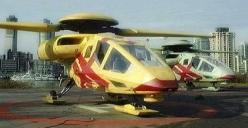Difference between revisions of "XMV-21 Condor"
From TheHolo.Net Forums Wiki
m |
|||
| Line 11: | Line 11: | ||
The '''XMV-21 Condor''' is an experimental aircraft developed by [[Treadstone Industries]] during the 1980s and 1990s. It is capable of VTOL flight like a conventional aircraft, but can "convert" for high-speed jet-powered flight like a conventional fixed-wing aircraft. | The '''XMV-21 Condor''' is an experimental aircraft developed by [[Treadstone Industries]] during the 1980s and 1990s. It is capable of VTOL flight like a conventional aircraft, but can "convert" for high-speed jet-powered flight like a conventional fixed-wing aircraft. | ||
| − | The design was never adopted by the US Military, but two prototypes exist. They are currently stored at a secure Treadstone facility at [[El Toro]], and have been | + | The design was never adopted by the US Military, but two prototypes exist. They are currently stored at a secure Treadstone facility at [[El Toro]], and have been "adopted" by [[X-Force]]. |
== History == | == History == | ||
Latest revision as of 21:07, 8 May 2012
The XMV-21 Condor is an experimental aircraft developed by Treadstone Industries during the 1980s and 1990s. It is capable of VTOL flight like a conventional aircraft, but can "convert" for high-speed jet-powered flight like a conventional fixed-wing aircraft.
The design was never adopted by the US Military, but two prototypes exist. They are currently stored at a secure Treadstone facility at El Toro, and have been "adopted" by X-Force.
History
The 1980s saw a number of major developments in VTOL aircraft in America. The AV-8 Harrier and it's successor had already become a popular craft with the United States Marine Corps, and the United States Army began their JVX program, which would ultimately lead to the V-22 Osprey.
The United States Navy also pursued the development of VTOL craft, beginning a Patrol Airship Concept Evaluation Study (PACES) in 1983. Their aim was to develop a non-rigid airship with tilt rotors to be used as a patrol craft, provisionally designated the PV-21. The project was ultimately abandoned by the Navy, but the concept itself caught the attention of Treadstone Industries.
Having recently lost out on the JVX contract, Treadstone's R&D teams had been searching for alternate areas of the United States military that could benefit from a VTOL craft. Taking inspiration from the PACES project, they set to work developing a multi-role aircraft that could potentially fill a variety of combat and utility roles for the United States Navy. After several years in development, they produced a pair of proof-of-concept craft, designated the XMV-21 Condor by the Navy during classified trials in 1992.
Most VTOL craft had a single means of propulsion that was capable of transitioning between vertical and horizontal flight. The XMV-21 was different, employing a rotary wing for vertical ascent with jet engines for forward thrust. A complex mechanism allowed the rotor blades to convert into fixed wings for high-speed flight, allowing the Condor to travel much faster than a conventional helicopter could.
Though the XMV-21 far exceeded expectations, concerns over the cost and complexity of it's dual flight system prevented any further development of the design. Years later however, engineers at Treadstone Industries would draw upon elements of the design when developing the UV-24 Peregrine.
Out of Character
The appearence and design of the XMV-21 Condor is based on the Whispercraft in the action movie 6th Day. The XMV designation means "Experimental Multi-Role VTOL" according to the 1962 United States Tri-Service aircraft designation system.
There is no V-21 in real life. However, the designation was reserved for a hypothetical PV-21, exactly as mentioned in this page.


